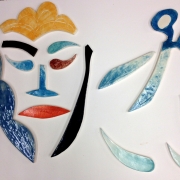belatrova in Iberia
belatrova, musing by a pool in the heat of Sotogrande, with a distant view of the Rock of Gibraltar, discovered that Andalusia has some of the hottest areas in Europe, sometimes averaging above 36 C in summer, with daytime highs of over 40 C. This explains the landscape of Holly and Cork Oak and the Pinsapo Fir trees that do well here, as do the olive trees that are grown all over the area.
Andalusia certainly knows its olives: Manzanilla, Arbequina, Empeltre, Sevillano, Picual, Hojiblanca, Picolimon, Verdial are just some of the estimated 260 different varieties of olive in Spain, which, as we all know, always look their best when offered to guests in a belatrova bowl.
But we digress. After being controlled by Carthaginians, Romans, Vandals and Visigoths, for half a millennium “Al-Andalus” was part of a Muslim caliphate, from the moment in 711 a Berber called Tariq ibn Ziyad landed his troops on the coast at a place that would become “Jabel alTariq” (the mountain of Tariq), now pronounced “Gibraltar”. Then came the Catholic Kings, and so on, until Spain became a member of the European Community. How about that for a quick outline of Spanish history?
Before arriving in Sotogrande belatrova had spent a short time in Malaga, port city of misty mornings and birthplace of the greatest artists of the 20th Century*, and paid a visit to the Museo Picasso de Malaga to have a peek at the great man’s ceramics and paintings on display. A small but fine collection that will satisfy anyone interested in art and ceramics.
After 90 minutes of leaving Malaga and driving south belatrova suddenly saw the strange presence of the large rock that is part of Britain. It is surprising that there is this tiny enclave with red telephone boxes, bobbies and pubs in the southernmost tip of Spain. But we stayed in Sotogrande and enjoyed the calm of this beautiful location.
Next stop was a few days near Ronda in a small town called Arriate. Early in the mornings, before the sun clears the horizon and bakes everything in its path, a quick walk into Arriate will reward you with a breakfast of “Churros con chocolate” before returning and finding a shady area in the house or by the pool. belatrovians have already met Thelonius the Pugmill (blog November 2013).
Though it may upset Thelonius, the churro-making machine is basically the same idea. Stuff goes in one end and is squeezed out the other, though in the former’s case it cannot be eaten with chocolate:

abandoned pottery in Arriate with stork’s nest on the top, seen when wandering into the village for breakfast
As for Ronda, it is a buzzing and welcoming town whose most well-known feature is the gorge that divides it and the bridge that crosses it, both made famous by the series of brilliant oil paintings David Bomberg made when he lived there in the 1930s.
Next stop was Granada, at the foot of the Sierra Nevada, home of the poet Federico García Lorca and of the Alhambra, Moorish citadel and palace, and the most renowned building of the Andalusian Islamic legacy. Any lover of mosaic and tiles would love its interior, but frankly anybody with an ounce of romance and fantasy would fall for it.
Saturation of visual sensation means you will end up agreeing with the poet Franciscio de Icaza who wrote “Give him alms, woman, for there is nothing sadder in life than being blind in Granada.” (“Dale limosna mujer, que no hay en la vida nada como la pena de ser ciego en Granada.”)
Walking along the narrow streets of the Albaicín district is also enthralling. Lots of shops selling pots and ceramics of all kind.
Even the street names are made of ceramic.
A visit to the Moorish Baths was a cool break from the sun and heat outside: looking up at the ceiling from the gloomy depths of the 11th Century building, the shapes cut out originally to allow steam to escape let in the daylight and shine like stars.
All a distant memory. Now back at the workshop at No 9, belatrova is busy preparing for h.Art events which will be from 6th – 14th September and to which you are all most welcome. We will be open from 10.00 to 17.30. Remember to follow the bright red h.Art signs.
And if you are near Ross-on-Wye, please drop in at the Studio Gallery which had a very successful launch some days ago and has an excellent display of belatrova ceramics.
* any belatrovian agreeing or disagreeing with this statement is invited to leave a comment. Comments will be awarded points, and points mean prizes … and, much as we would like to give the winner a Picasso bowl, you could win yourself a belatrova Valencia three legged ceramic instead.



























Belatrova has shown, one more time, its great sensibility descriving Andalucian sensations ! Thelonius and the churro machine comparison is pretty accurate !!